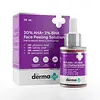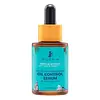What's inside
What's inside
 Key Ingredients
Key Ingredients

 Benefits
Benefits

 Concerns
Concerns

 Ingredients Side-by-side
Ingredients Side-by-side

Water
Skin ConditioningGlycolic Acid
BufferingLactic Acid
BufferingMandelic Acid
AntimicrobialAloe Barbadensis Leaf Juice
Skin ConditioningPropylene Glycol
HumectantVaccinium Myrtillus Bud Extract
AntioxidantBeta Vulgaris Root Extract
Skin ConditioningSodium Hydroxide
BufferingSalicylic Acid
MaskingChamomilla Recutita Extract
Skin ConditioningCalendula Officinalis Flower Extract
MaskingPanthenol
Skin ConditioningSodium Hyaluronate
HumectantCamellia Sinensis Leaf Extract
AntimicrobialCucurbita Pepo Seed Extract
Skin ConditioningXanthan Gum
EmulsifyingPhenoxyethanol
PreservativeChlorphenesin
AntimicrobialSodium Benzoate
MaskingWater, Glycolic Acid, Lactic Acid, Mandelic Acid, Aloe Barbadensis Leaf Juice, Propylene Glycol, Vaccinium Myrtillus Bud Extract, Beta Vulgaris Root Extract, Sodium Hydroxide, Salicylic Acid, Chamomilla Recutita Extract, Calendula Officinalis Flower Extract, Panthenol, Sodium Hyaluronate, Camellia Sinensis Leaf Extract, Cucurbita Pepo Seed Extract, Xanthan Gum, Phenoxyethanol, Chlorphenesin, Sodium Benzoate
Water
Skin ConditioningNiacinamide
SmoothingSalicylic Acid
MaskingPropanediol
SolventCamellia Sinensis Extract
AntioxidantMelia Azadirachta Extract
Skin ConditioningSalix Alba Bark Extract
AstringentAloe Barbadensis Leaf Extract
EmollientSodium Lactate
BufferingSodium Gluconate
Skin ConditioningBetaine
HumectantPhenoxyethanol
PreservativeEthylhexylglycerin
Skin ConditioningSodium Hyaluronate
HumectantPanthenol
Skin ConditioningSodium Benzoate
MaskingPotassium Sorbate
PreservativeHeptyl Glucoside
Hydroxyethyl Urea
HumectantXanthan Gum
EmulsifyingAllantoin
Skin ConditioningMelaleuca Alternifolia Leaf Oil
AntioxidantTocopheryl Acetate
AntioxidantWater, Niacinamide, Salicylic Acid, Propanediol, Camellia Sinensis Extract, Melia Azadirachta Extract, Salix Alba Bark Extract, Aloe Barbadensis Leaf Extract, Sodium Lactate, Sodium Gluconate, Betaine, Phenoxyethanol, Ethylhexylglycerin, Sodium Hyaluronate, Panthenol, Sodium Benzoate, Potassium Sorbate, Heptyl Glucoside, Hydroxyethyl Urea, Xanthan Gum, Allantoin, Melaleuca Alternifolia Leaf Oil, Tocopheryl Acetate
Ingredients Explained
These ingredients are found in both products.
Ingredients higher up in an ingredient list are typically present in a larger amount.
Panthenol is a common ingredient that helps hydrate and soothe the skin. It is found naturally in our skin and hair.
There are two forms of panthenol: D and L.
D-panthenol is also known as dexpanthenol. Most cosmetics use dexpanthenol or a mixture of D and L-panthenol.
Panthenol is famous due to its ability to go deeper into the skin's layers. Using this ingredient has numerous pros (and no cons):
Like hyaluronic acid, panthenol is a humectant. Humectants are able to bind and hold large amounts of water to keep skin hydrated.
This ingredient works well for wound healing. It works by increasing tissue in the wound and helps close open wounds.
Once oxidized, panthenol converts to pantothenic acid. Panthothenic acid is found in all living cells.
This ingredient is also referred to as pro-vitamin B5.
Learn more about PanthenolPhenoxyethanol is a preservative that has germicide, antimicrobial, and aromatic properties. Studies show that phenoxyethanol can prevent microbial growth. By itself, it has a scent that is similar to that of a rose.
It's often used in formulations along with Caprylyl Glycol to preserve the shelf life of products.
Salicylic Acid (also known as beta hydroxy acid or BHA) is a well-known ingredient for treating skin that struggles with acne and clogged pores. It exfoliates both the skin's surface and deep within the pores to help clear out buildup, control oil, and reduce inflammation.
Unlike AHAs (alpha hydroxy acids), salicylic acid is oil-soluble. This allows it to penetrate into pores which makes it especially effective for treating blackheads and preventing future breakouts.
Salicylic acid is also known for its soothing properties. It has a similar structure to aspirin and can calm inflamed or irritated skin, making it a good option for acne-prone skin that is also sensitive.
Concentrations of 0.5-2% are recognized by the U.S. FDA as an over-the-counter topical acne product.
It can cause irritation and/or dryness if one's skin already has a compromised moisture barrier, so it's best to focus on repairing that before introducing this ingredient into your routine.
While salicylic acid does not increase sun sensitivity, it’s still important to wear sunscreen daily to protect your skin.
If you are looking for the ingredient called BHA or Butylated Hydroxyanisole, click here.
Learn more about Salicylic AcidSodium Benzoate is a preservative. It's used in both cosmetic and food products to inhibit the growth of mold and bacteria. It is typically produced synthetically.
Both the US FDA and EU Health Committee have approved the use of sodium benzoate. In the US, levels of 0.1% (of the total product) are allowed.
Sodium benzoate works as a preservative by inhibiting the growth of bacteria inside of cells. It prevents the cell from fermenting a type of sugar using an enzyme called phosphofructokinase.
It is the salt of benzoic acid. Foods containing sodium benzoate include soda, salad dressings, condiments, fruit juices, wines, and snack foods.
Studies for using ascorbic acid and sodium benzoate in cosmetics are lacking, especially in skincare routines with multiple steps.
We always recommend speaking with a professional, such as a dermatologist, if you have any concerns.
Learn more about Sodium BenzoateSodium Hyaluronate is hyaluronic acid's salt form. It is commonly derived from the sodium salt of hyaluronic acid.
Like hyaluronic acid, it is great at holding water and acts as a humectant. This makes it a great skin hydrating ingredient.
Sodium Hyaluronate is naturally occurring in our bodies and is mostly found in eye fluid and joints.
These are some other common types of Hyaluronic Acid:
Learn more about Sodium HyaluronateWater. It's the most common cosmetic ingredient of all. You'll usually see it at the top of ingredient lists, meaning that it makes up the largest part of the product.
So why is it so popular? Water most often acts as a solvent - this means that it helps dissolve other ingredients into the formulation.
You'll also recognize water as that liquid we all need to stay alive. If you see this, drink a glass of water. Stay hydrated!
Learn more about WaterXanthan gum is used as a stabilizer and thickener within cosmetic products. It helps give products a sticky, thick feeling - preventing them from being too runny.
On the technical side of things, xanthan gum is a polysaccharide - a combination consisting of multiple sugar molecules bonded together.
Xanthan gum is a pretty common and great ingredient. It is a natural, non-toxic, non-irritating ingredient that is also commonly used in food products.
Learn more about Xanthan Gum